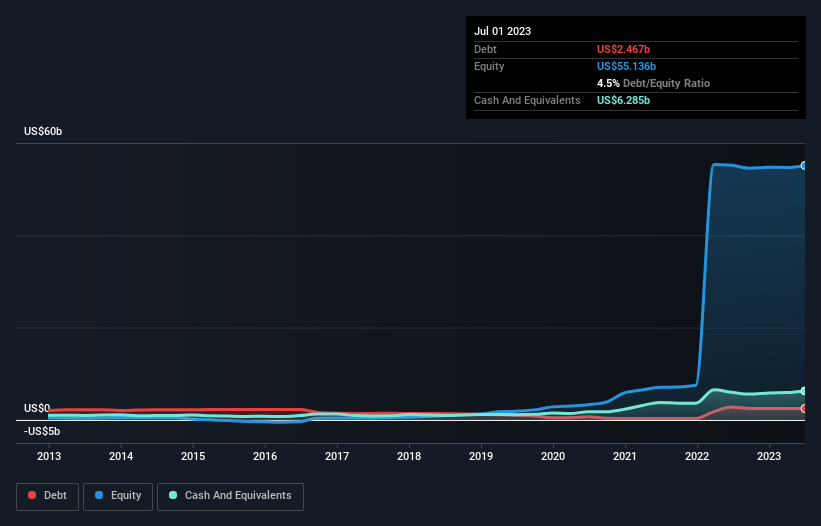Is Advanced Micro Devices (NASDAQ:AMD) Weighed On By Its Debt Load?
The external fund manager backed by Berkshire Hathaway's Charlie Munger, Li Lu, makes no bones about it when he says 'The biggest investment risk is not the volatility of prices, but whether you will suffer a permanent loss of capital.' It's only natural to consider a company's balance sheet when you examine how risky it is, since debt is often involved when a business collapses. We can see that Advanced Micro Devices, Inc. (NASDAQ:AMD) does use debt in its business. But the more important question is: how much risk is that debt creating?
When Is Debt Dangerous?
Debt assists a business until the business has trouble paying it off, either with new capital or with free cash flow. In the worst case scenario, a company can go bankrupt if it cannot pay its creditors. However, a more common (but still painful) scenario is that it has to raise new equity capital at a low price, thus permanently diluting shareholders. Having said that, the most common situation is where a company manages its debt reasonably well - and to its own advantage. The first thing to do when considering how much debt a business uses is to look at its cash and debt together.
See our latest analysis for Advanced Micro Devices
What Is Advanced Micro Devices's Debt?
As you can see below, Advanced Micro Devices had US$2.47b of debt at July 2023, down from US$2.78b a year prior. However, its balance sheet shows it holds US$6.29b in cash, so it actually has US$3.82b net cash.
How Strong Is Advanced Micro Devices' Balance Sheet?
Zooming in on the latest balance sheet data, we can see that Advanced Micro Devices had liabilities of US$7.57b due within 12 months and liabilities of US$5.26b due beyond that. Offsetting this, it had US$6.29b in cash and US$4.31b in receivables that were due within 12 months. So it has liabilities totalling US$2.23b more than its cash and near-term receivables, combined.
This state of affairs indicates that Advanced Micro Devices' balance sheet looks quite solid, as its total liabilities are just about equal to its liquid assets. So while it's hard to imagine that the US$173.3b company is struggling for cash, we still think it's worth monitoring its balance sheet. While it does have liabilities worth noting, Advanced Micro Devices also has more cash than debt, so we're pretty confident it can manage its debt safely. The balance sheet is clearly the area to focus on when you are analysing debt. But ultimately the future profitability of the business will decide if Advanced Micro Devices can strengthen its balance sheet over time. So if you want to see what the professionals think, you might find this free report on analyst profit forecasts to be interesting.
In the last year Advanced Micro Devices's revenue was pretty flat, and it made a negative EBIT. While that hardly impresses, its not too bad either.
So How Risky Is Advanced Micro Devices?
While Advanced Micro Devices lost money on an earnings before interest and tax (EBIT) level, it actually generated positive free cash flow US$1.9b. So taking that on face value, and considering the net cash situation, we don't think that the stock is too risky in the near term. Until we see some positive EBIT, we're a bit cautious of the stock, not least because of the rather modest revenue growth. When analysing debt levels, the balance sheet is the obvious place to start. But ultimately, every company can contain risks that exist outside of the balance sheet. These risks can be hard to spot. Every company has them, and we've spotted 1 warning sign for Advanced Micro Devices you should know about.
If you're interested in investing in businesses that can grow profits without the burden of debt, then check out this free list of growing businesses that have net cash on the balance sheet.
Have feedback on this article? Concerned about the content? Get in touch with us directly. Alternatively, email editorial-team (at) simplywallst.com.
This article by Simply Wall St is general in nature. We provide commentary based on historical data and analyst forecasts only using an unbiased methodology and our articles are not intended to be financial advice. It does not constitute a recommendation to buy or sell any stock, and does not take account of your objectives, or your financial situation. We aim to bring you long-term focused analysis driven by fundamental data. Note that our analysis may not factor in the latest price-sensitive company announcements or qualitative material. Simply Wall St has no position in any stocks mentioned.

 Yahoo News
Yahoo News 

